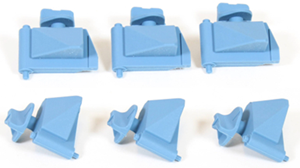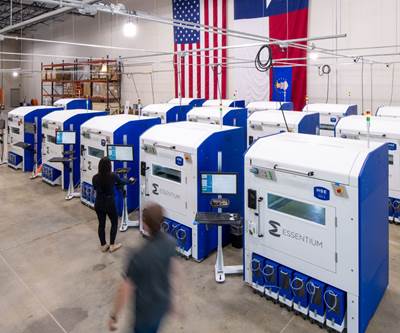Key Additive Manufacturing Trends to Watch in 2021
EOS, HP, Carbon and Essentium give a preview of what to expect from additive manufacturing in 2021.

Carbon will continue to look into the performance and protection market. Pictured here is a 3D printed custom helmet liner.
In 2019, I asked several additive manufacturing providers for their predictions and trends in 2020. Well, no one could have foreseen what would take place that year. But one of the key predictions—additive goes mainstream—did come to play in a big way.
“For manufacturers and consumers alike, COVID-19 has been a reminder of our infrastructure fragility and has become an accelerant for change in the industry,” said Ramon Pastor, head of 3D printing technology, operations, and metals, HP Inc. “The global supply chain was upended in ways never seen before, and 3D printing proved to be a critical part of the solution.”
While there is so much unknown at the moment, AM will continue to make its mark in end-use production. Here’s what EOS, HP, have to say about the trends for 2021.
What do you see as the key trends for 3D printing in 2021?
Marie Langer, CEO of EOS, believes that in large part due to the pandemic, one of the greatest lessons learned collectively in 2020 is that as an organization, one of your most important priorities is societal impact.
“For that reason, in 2021, I predict that sustainability will continue to be a huge priority for the 3D printing industry,” she said.
“At EOS, we see the societal impact of sustainability in three levels: technology, humanity and corporate. On the technology level, we look to further improve the resource efficiency of our technology (electricity, powder etc.) and introduce biodegradable materials. We create technology that will enable lightweighting, extend product life, and reconfigure value chains and inventory waste reduction by introducing an AM-based, spare parts on-demand concept.
On a humanity level, we work to enable applications with additive manufacturing to improve people’s lives through products like orthopedic implants; orthoses and prostheses; footwear; protective gear and smart wearables. On a corporate level, our focus is on circular economy concepts, such as our recycling program for polymer powders in Germany. We strive to constantly improve our own waste management, continue to improve the energy consumption of our systems, processes, and buildings, including e-bike support or e-car-charging stations for our staff.
In addition to sustainability, another major trend for AM in 2021 is production in general will become more digital, decentralized, and flexible in 2021 to better adapt to ever changing market requirement and customer needs. As proven during the pandemic, additive manufacturing is primed to address this.
Overall, a combined approach to digitization, industrialization and sustainability will be the biggest trend to watch out for in 2021 and the years to come. It will be essential to integrate industrial 3D printing into the digital value chain of production and to further industrialize our technology for series production, with the holistic goal of sustainability. At EOS, we believe additive manufacturing is truly integral for the future of responsible manufacturing.”
Philipp Jung, head of end-to-end solutions, personalization & 3D printing, HP, said that across the 3D printing industry, top trends will include economic advancement, increased collaboration, accelerated innovation, personalization and sustainable production. “Most prominently, we’re seeing a rise in manufacturers seeking mass customization capabilities in response to the rapid shift toward product personalization. And according to HP’s Digital Manufacturing Trends Report, 91% of respondents noted they would pursue mass customization if they could personalize parts via 3D printing,” he said.
“With 3D printing, we’re able to transform entire sectors by introducing a whole new set of capabilities. HP’s partnerships with leading orthotics companies and major golf manufacturers, for example, are proof of what’s possible when we take full advantage of digital manufacturing to create innovative designs and deliver individualized products.”
Carbon SVP of Materials Jason Rolland predicts a larger trend of pushing toward better materials and production-grade materials.
“The demand for polymeric materials in additive and performance continues to rise,” he said. “It’s not okay to have brittle resins. I lead our materials team and we have a whole bunch of stuff in the pipeline to improve material properties that are more or less on par with injection molding resins.”
Rolland said that Carbon is looking heavily into the performance and protection market—whether it’s helmets, padding, car seats—and seeing where there is a tremendous advantage with lattice coupled with high performance materials.
He also sees customization will continue to be an important focus.
Blake Teipel, CEO and co-founder of Essentium, encourages companies to be bold in investment choices in 2021.
“Additive has already working behind the scenes the past 30 years on all kinds of applications so now is the time if you are thinking about investing in additive,” he said. “Is additive ready for primetime? The answer is yes.”
Related Content
Additive Fusion Technology Optimizes Composite Structures for Demanding Applications
9T Labs continues to enhance the efficiency of its technology, which produces composite parts with intentionally oriented fibers.
Read MoreBusiness Slowing? There's Still Plenty of Stuff to Do
There are things you may have put off when you were occupied with shipping parts to customers. Maybe it’s time to put some of them on the front burner.
Read More3D Printing of Injection Molds Flows in a New Direction
Hybrids of additive manufacturing and CNC machining can shorten tooling turnaround times.
Read More3D Printed Spine Implants Made From PEEK Now in Production
Medical device manufacturer Curiteva is producing two families of spinal implants using a proprietary process for 3D printing porous polyether ether ketone (PEEK).
Read MoreRead Next
20 Good Things to Come Out of 2020—Part 5
Additive manufacturing has emerged as the supply chain hero in many ways during the COVID-19 pandemic. While the recycling industry continues its push for a Circular Economy.
Read MoreBridging the Gap Between 3D Printing and Traditional Manufacturing
At Essentium, both 3D printers and materials receive starring roles.
Read MoreStudy: 3D Printing Helps Strengthen Supply Chains
HP’s Digital Manufacturing Trend Report finds that companies are increasingly investing in advanced 3D printing solutions that provide the agility, speed, and flexibility necessary to grow their business.
Read More


























